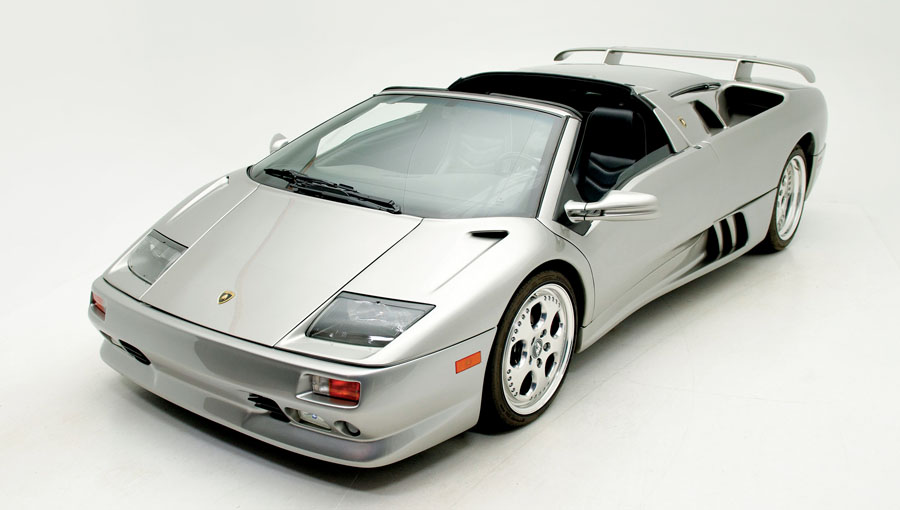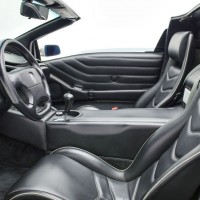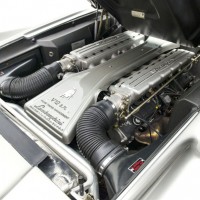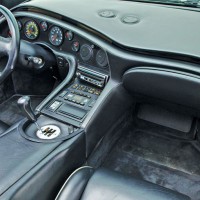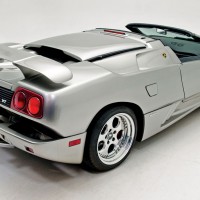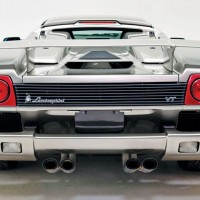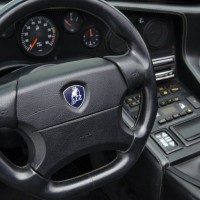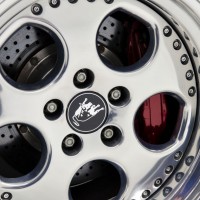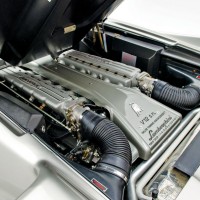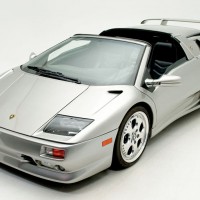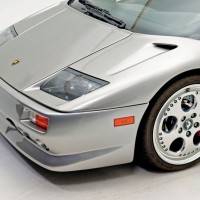This 1999 Lamborghini Diablo VT roadster is exceptionally rare by virtue of its special-order Titanium Silver Metallic paint, which is matched with a black leather interior with gray piping and accent stitching. Sparingly driven and showing just 30,188 miles, it features the visually stunning mid-mounted V12, 5-speed manual transmission, hydraulic front lift system for ramp clearance, an aftermarket exhaust system, aftermarket stereo head unit with six-disc CD player with remotes, and on-board navigation. The Diablo’s polished alloy wheels, which closely recall the Countach’s, are shod with newer BF Goodrich radial tires and are slowed by cross-drilled and vented disc brakes with Rosso Vik painted calipers. The car is fresh from a $12,500 major service and now features front-end clear-bra protection including leading edge surfaces. The owner’s manual, tools, remotes and a car cover are included. From the Roy Cats Lamborghini Collection.
SCM Analysis
Detailing
| Vehicle: | 1999 Lamborghini Diablo VT Roadster |
| Years Produced: | 1990–2001 |
| Number Produced: | 2,884 (all variants) |
| Original List Price: | $286,300 (1999 VT) |
| SCM Valuation: | $65,000–$135,000 |
| Tune Up Cost: | $4,000 (15,000-mile service, without clutch replacement) |
| Distributor Caps: | N/A (uses coil packs) |
| Chassis Number Location: | Rear right section of engine bay below airbox |
| Engine Number Location: | Between both cylinder heads towards rear of block |
| Club Info: | Lamborghini club of America |
| Website: | http://www.lamborghiniclubamerica.net |
| Alternatives: | 1995–2001 Ferrari F50, 1991–95 Cizeta-Moroder V16T (the original Diablo), 1992–95 Bugatti EB110 |
| Investment Grade: | B |
This car, Lot 189, sold for $183,600, including buyer’s premium, at Mecum’s Seattle, WA, auction on June 6, 2015.
My friends and I are a lot more pragmatic than our parents were. We eschew aged steaks for quinoa salad, outside of work we wear vintage clothes, we like small houses, and we prefer diesels and hybrids to gas-guzzling SUVs and sports cars. We are more concerned about global climate change than we are about the temperature of our wine cellar. Our ideal transportation might be a Volvo 240DL or a Volkswagen Jetta TDI.
What once was boring and staid is now hip. Transportation that young, hip people used to aspire to — such as the Ferrari F50, Porsche 911 Turbo and, without fail, the Lamborghini Diablo — are of minimal interest to your average 30-year-old. But there’s always that one percent….
Let’s play a guessing game
Think of the coolest car from the 1960s (it’s really tiny, air-cooled and German), the best car from the 1980s (it was Motor Trend’s Foreign Car of the Year in 1981 — think “Chrysler” and “K”) or the most iconic, outrageous car of the 1990s.
Younger collectors grew up with Matchbox cars in the ’90s, and in nearly every giant bonus pack of tiny cars, there was a white, black or red Lamborghini Diablo. What a great way to indoctrinate small children with a subconscious desire for a car that will have long been out of production by the time they can afford it.
Due in part to this subtle marketing initiative, we can say that the Diablo is the most iconic car of the 1990s — and icons never go out of style or become valueless. If I were wrong, some lucky thrift-store-roving hipster in Los Angeles would be wearing Steve McQueen’s jacket.
Two different flavors of Diablo, one complex V12
While the Diablo was pretty much the same from 1990 to 1999, in 2000 Audi upgraded the entire car, most importantly with a faster 6-liter V12. These late 6-liter cars always sell for $50,000 to $100,000 more than a 5.7-liter version. A 5.7-liter car is valued somewhere between $100,000 and $150,000 today.
Our subject car’s sale price of $183,600 is strong, and looking at it in detail only reinforces this finding.
Our subject car had a whopping 30,000 miles on it. Keep in mind, the Lambo V12 engine was designed back in the early 1960s with an expected life of 35,000 miles between rebuilds. While materials have improved over time, I examined a normal-use 5.7-liter Lamborghini V12 on the operating table of my machinist’s workshop, and at 10,000 miles, valve guides and cylinder liners were in need of attention.
Each engine was hand-built, many parts were sand-cast alloys, and the whole unit was under a massive amount of stress. If, at 30,000 miles, this motor has not been gone through, things are about to get expensive. Does this make it a bad car? No, but I encourage anyone who is buying a high-mileage exotic to scrutinize its service history before purchasing it.
Given the quality of specimens from Mr. Cats’ collection, I would say it’s possible all the major engine needs have been fulfilled (although $12,500 won’t even buy you a clutch replacement on a Diablo). Otherwise, the Diablo is an artisan machine with a hand-built frame and an outlandish exterior.
Young buyers and old supercars
I have no idea who bought this car, but that leaves room to continue our guessing game.
First off, if I wanted a cool supercar but didn’t have the money for a new Lambo, I would consider a car like this. Yes, at less than 20 years old, it is still a used car, and when a new example is out of reach, you go for a used one, right? The only flaw in this theory is that the Murciélago, which is newer, can be had for similar money, and there are cheaper Diablos for sale.
My second theory has to do with a potential Millennial or Gen X purchaser who grew up playing with a toy Diablo or Countach, and quietly resolved to buy one when he or she “arrived.” The truth about Millennials and collectible cars is that tastes are individual and diverse.
We don’t subscribe readily to the mass-hysteria markets that are making air-cooled Porsches and Enzo-era Ferraris investments first and pleasure objects second. We just buy what we like.
Or how about this: Let’s imagine our buyer is a successful 30-year-old who has won the start-up lottery and wishes to reward himself. Supercars haven’t changed much, and there is almost nowhere on a public road to use them at their limit.
It’s possible that the buyer purchased this car to get 200-mph performance — while avoiding the depreciation of a new Aventador. He or she might even break even when selling it. In addition, many of the new supercars (and there are so many of them) are not that recognizable or distinctive.
Because the Diablo is an icon, everyone who cares about this sort of thing knows what it is. While our parents often pursue the newest and best, we always look for a practical deal. The Diablo is as timeless as the Clinton-Lewinsky scandal (another unforgettable 1990s icon) and as cool now as it was then. Well sold, but wisely bought for the 10-year depreciation curve of a new Lamborghini. ♦
(Introductory description courtesy of Mecum.)
